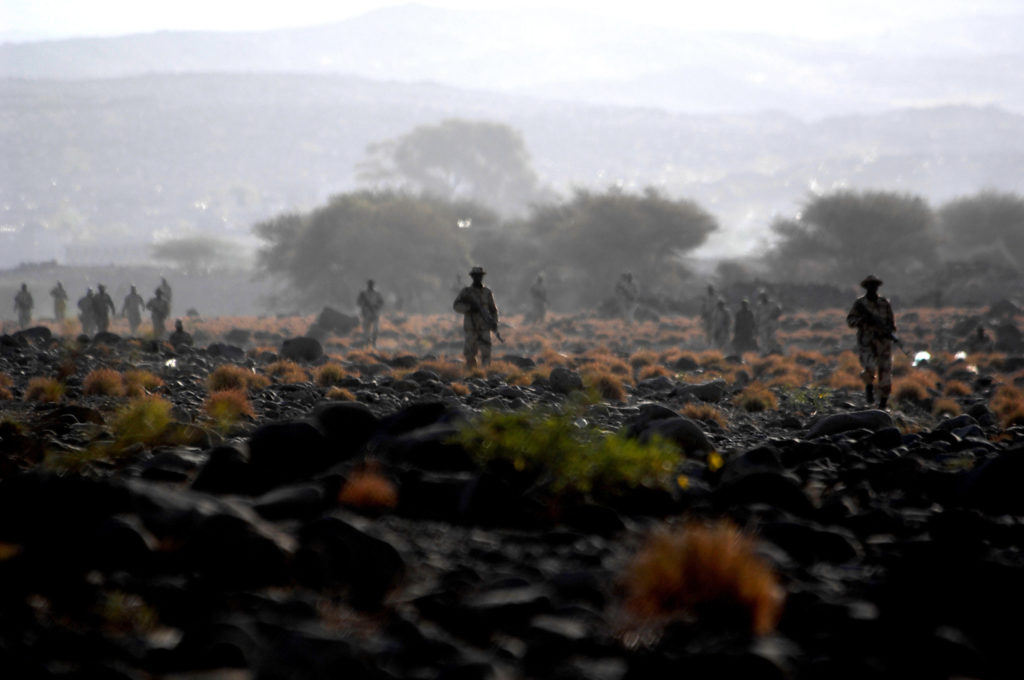Trends in Terrorism: What’s on the Horizon in 2023?

Bottom Line
- The most defining feature of international terrorism in 2023 will be its diversity, reflected by the broad array of ideologies and grievances motivating plots and attacks.
- The challenge of dealing with “everyday extremists” remains, as lone actors influenced by accelerationism and other forms of violent extremism radicalize online and seek to conduct real-world acts of politically and ideologically motivated violence.
- The threat landscape may now appear far more inchoate, which makes it difficult to combat, but it may also be less potent as a result. For terrorism and counterterrorism analysts, 2023 will be among the most unpredictable years in recent memory.
The most defining feature of international terrorism in 2023 will be its diversity, reflected by the broad array of ideologies and grievances motivating plots and attacks. The Islamic State, the most significant terrorist threat since the global counterterrorism campaign to dismantle al-Qaeda in the immediate years following 9/11, has been attenuated in Iraq and Syria, losing two of its emirs in 2022. Outside of the Levant, Islamic State branches and affiliates remain potent, especially in the Sahel region of Africa and in South Asia, where the Islamic State Khorasan Province is waging a stubborn insurgency against the Taliban. The Islamic State Khorasan Province has launched high-profile attacks against both Russian and Chinese interests in Afghanistan. Still, Western counterterrorism successes may not be sustainable without a robust commitment to continue working with partners on the ground to ensure that these groups do not reconstitute. Without continued US and allied pressure, it is likely that Islamic State, al-Qaeda, and their respective branches and franchise groups could successfully rebuild their networks in the Middle East and beyond.
And while the United States and its coalition partners have done an impressive job at destroying the physical caliphate in the Middle East, sub-Saharan Africa is now the center of gravity for jihadist terrorism. In West Africa, the al-Qaeda-linked Jama’at Nasr al-Islam wal Muslimin and the Islamic State West Africa Province are competing for resources and recruits and, in the process, leaving a deadly trail of destruction in their wake. According to the Global Terrorism Index, the Sahel has become “increasingly more violent over the past 15 years, with deaths rising by over one thousand percent between 2007 and 2021.”
Given porous borders, political instability (to include several coups), and a host of socio-economic grievances, the region is expected to remain a tinderbox for the foreseeable future. As countries like France and the United States further reduce their counterterrorism footprint abroad, shifting focus to great power competition with Russia and China, it could provide openings for jihadist groups in Africa to expand their influence and control over territory. On the other side of the continent, al-Shabaab is still a pernicious threat and could be looking to expand operations beyond Somalia and the immediate region, setting sights on more global ambitions. Two al-Shabaab militants have been arrested in the Philippines over the past several years, both charged with attempting to plan “9/11-style” attacks using airplanes. If an African jihadist group sees an opportunity to gain momentum, and with it money and recruits, it could make attacking Western targets a higher priority. As terrorism experts Bruce Hoffman and Jacob Ware recently suggested, in a post-Zawahiri era, al-Qaeda is likely to refocus on targeting embassies and consulates, tourist destinations, and commercial aviation.
One of the recent trends to garner attention is the concept of ‘post-organizational violent extremism and terrorism’ (POVET), a concept Bruce Hoffman and I referenced in a July 2020 piece on domestic terrorism in the United States, where we highlighted “the growing irrelevance or organizational structure.” This trend has continued. In May 2022, a racially motivated terrorist attack by Payton Gendron at a grocery store in a predominantly African-American section of Buffalo, NY left ten dead. Gendron had been influenced, at least in part, by the Great Replacement theory. He also copied and pasted entire sections of the manifesto published by Brenton Tarrant, the white supremacist responsible for the Christchurch massacre in 2019. While both of these individuals, as well as those responsible for attacks in El Paso, TX and Pittsburgh, PA may be classified as lone actors, they emerged from a broader far-right ecosystem. In discussions with national security officials in the United States, the number one concern I hear is the potential for another Oklahoma City-style domestic terrorism attack from an anti-government extremist in the mold of Timothy McVeigh.
Post-organizational terrorism presents new threats for law enforcement and intelligence agencies. With no actual group there is no physical headquarters to surveil and no organization to infiltrate. There is a lower possibility of leakage—someone within the organization practicing poor operational security or prematurely discussing details of the plot. This is squarely in line with the concept of ‘leaderless resistance,’ designed to insulate the leadership of terrorist networks from being identified and arrested. The Islamic State, as much as it presented a challenge through its control of territory and ability to launch external attack operations, also presented an attractive target for the United States and its allies to strike. Post-organizational terrorism presents no such target. However, post-organizational terrorists also lack the logistics and support networks of terrorist groups, and accordingly, are more limited in the amount of damage they can inflict. These networks are less able to marshal resources and are incapable of conducting prolonged sieges of enduring campaigns of violence. Still, since the goal of terrorism is largely psychological, even a lone actor with access to sophisticated weaponry can wreak havoc on a mass scale. In the United States, where individuals have access to automatic weapons, the threat is magnified exponentially.
With far-right terrorism ascendant, we should expect more plots and attacks from racially and ethnically motivated violent extremists (REMVE), including white supremacists and neo-Nazis, as well as anti-government and anti-authority violent extremists, to including militia groups. In early December, German police and security services conducted countrywide raids to disrupt a conspiracy-driven plot by far-right extremists to overthrow the government. The QAnon conspiracy has continued to morph and evolve, taking root in countries like Germany, Japan, and elsewhere, functioning akin to a parasite, where it latches on and adapts to local contexts. Within the broader far-right umbrella, there is also a patchwork of ideologies motivating violent extremism, including among so-called ‘Incels,’ a subset of violent misogynist, as well as neo-Luddites or “technophobes,” who have increasingly targeted 5G cell towers and other critical infrastructure. Eco-fascists, sometimes referred to as “white supremacists going green,” have also carved out a particular niche among elements of the far-right.
State-sponsored terrorism is also making a comeback. The support of a global network of terrorist proxies forms the cornerstone of Iran’s foreign and security policy. The Russian Imperial Movement, a far-right terrorist group with links to the Kremlin, has been designated as a Specially Designated Global Terrorist entity by the United States. Russian proxy forces, including the Wagner Group and Task Force Rusich, a neo-Nazi paramilitary group, are active in Ukraine. Moscow could seek to instigate terrorist attacks on European soil in retaliation for what Russian President Vladimir Putin has described as NATO-sponsored terrorism, given the alliance’s support to Ukraine. A letter bomb campaign targeted Ukrainian embassies in Europe, as well as the US embassy in Madrid and several other buildings and agencies in Spain. While Russian links are suspected, the investigation remains ongoing. As the war in Ukraine drags on, fears over Russian terrorism in the West have grown.
Emerging technologies present terrorists and violent extremists with myriad options that terrorists in the past never had. Drones, 3-D printed weapons, virtual currencies, and end-to-end encryption offer lone actors sophisticated capabilities. A trend likely to continue is the online manifesto which often accompanies a high-profile far-right attack. These manifestos not only serve to radicalize would-be extremists, but also provide exquisitely detailed descriptions of attack preparation, weapons maintenance, and the aesthetics of the accelerationist ideology more broadly. This concept, which espouses anomic violence to bring about societal collapse, has contributed to an uptick in assassinations and assassination attempts directed against political figures. In July, former Japanese Prime Minister Shinzo Abe was assassinated by a lone actor using an improvised, or do-it-yourself firearm.
So just as the global jihadist threat continues to evolve—ebbing and flowing in different regions—the far-right continues to solidify its transnational connections. Meanwhile, the challenge of dealing with “everyday extremists” remains, as lone actors influenced by accelerationism and other forms of violent extremism radicalize online and seek to conduct real-world acts of politically and ideologically motivated violence. The US troop withdrawal from Afghanistan and the Taliban’s subsequent takeover in August 2021 could be framed as the logical bookend to the two-decade-long Global War on Terrorism. Of course, the United States and its allies will continue to carry out counterterrorism operations throughout the globe. But no longer will counterterrorism serve as a unifying mission set, nor as a placeholder for a broader grand strategy.
For terrorism and counterterrorism analysts, 2023 will be among the most unpredictable years in recent memory. Part of this is due to the fragmented nature of the threat, but also as a result of a yearslong relentless Western counterterrorism strategy that targeted Islamic State command-and-control and revoked the territory the group had once dubbed its Caliphate. The threat landscape may now appear far more inchoate, which makes it difficult to combat, but it may also be less potent as a result. Suppose the United States and its allies can discern an effective approach to balancing counterterrorism with great power competition. In that case, we might see a continuing trend of downward pressure on terrorist networks, mitigating the challenge of lone actors and small cells and relegating terrorist attacks primarily to active conflict zones.
The views expressed in this article are those of the author alone and do not necessarily reflect the position of the Foreign Policy Research Institute, a non-partisan organization that seeks to publish well-argued, policy-oriented articles on American foreign policy and national security priorities.
Image: Defense Department


